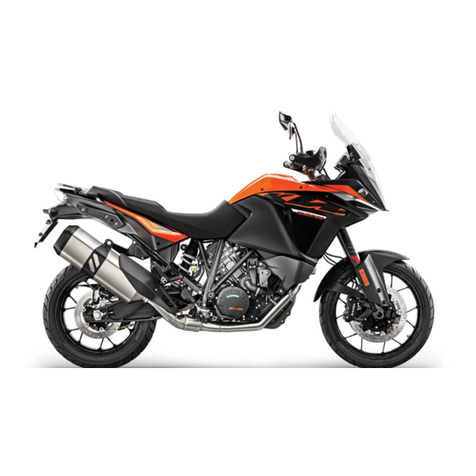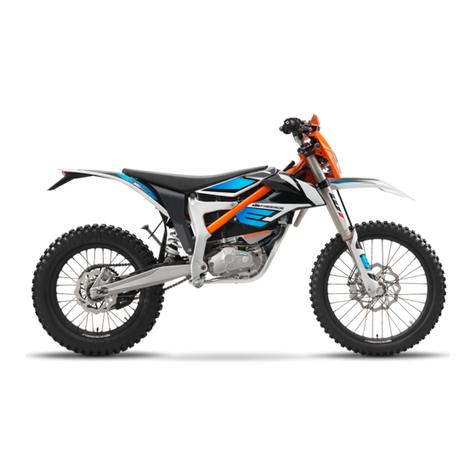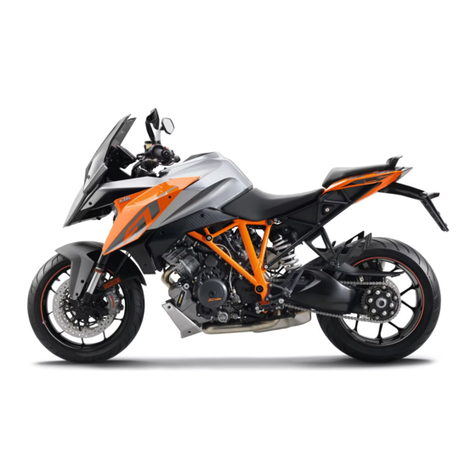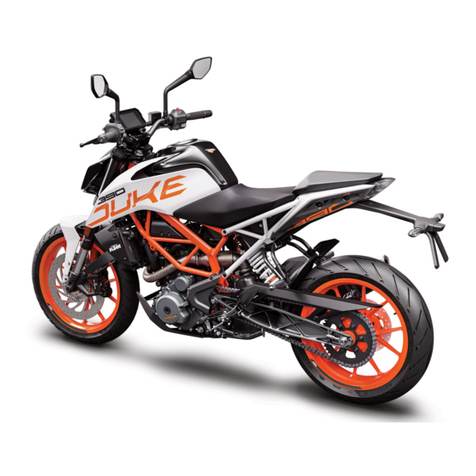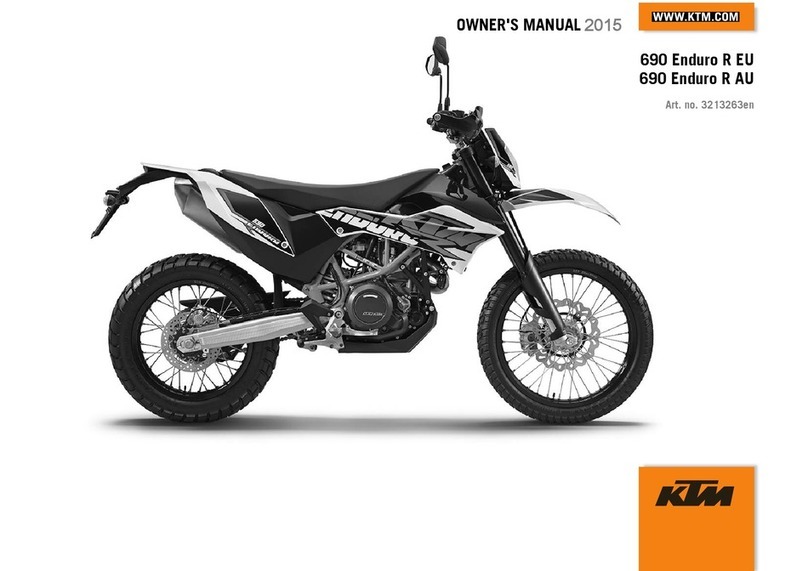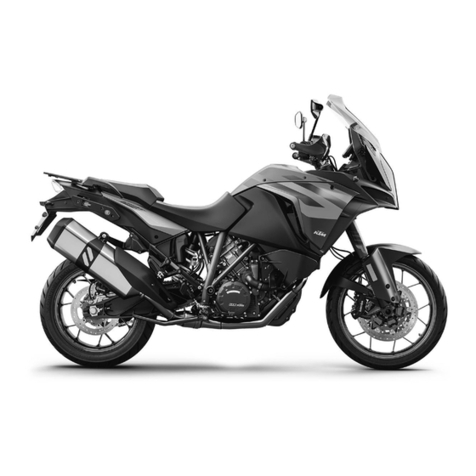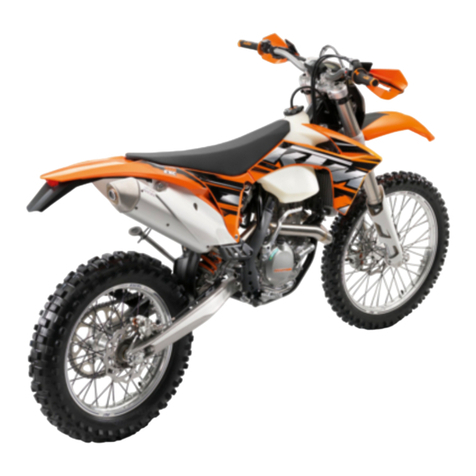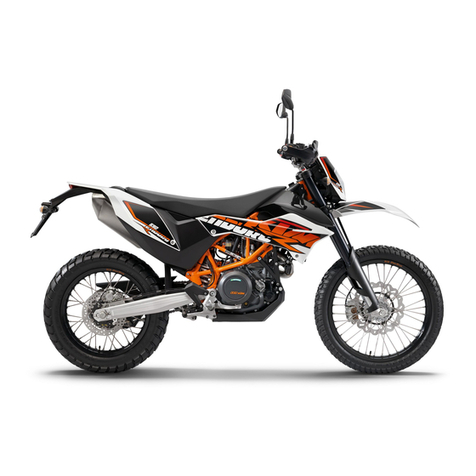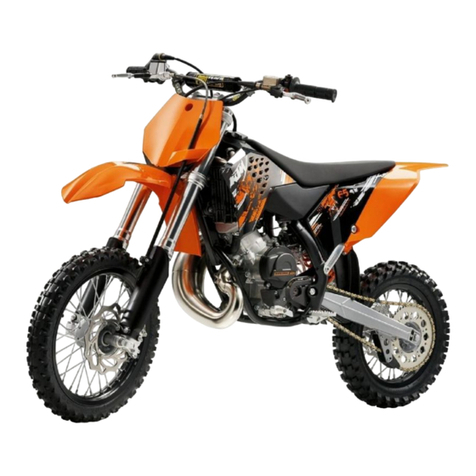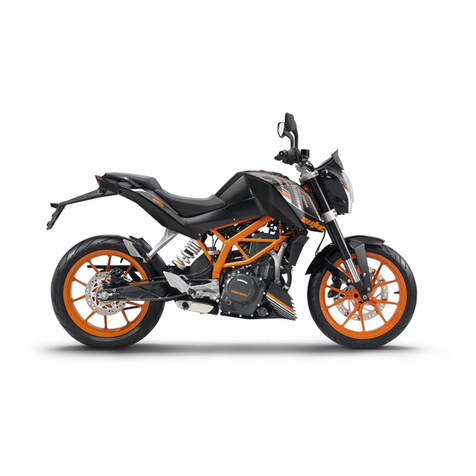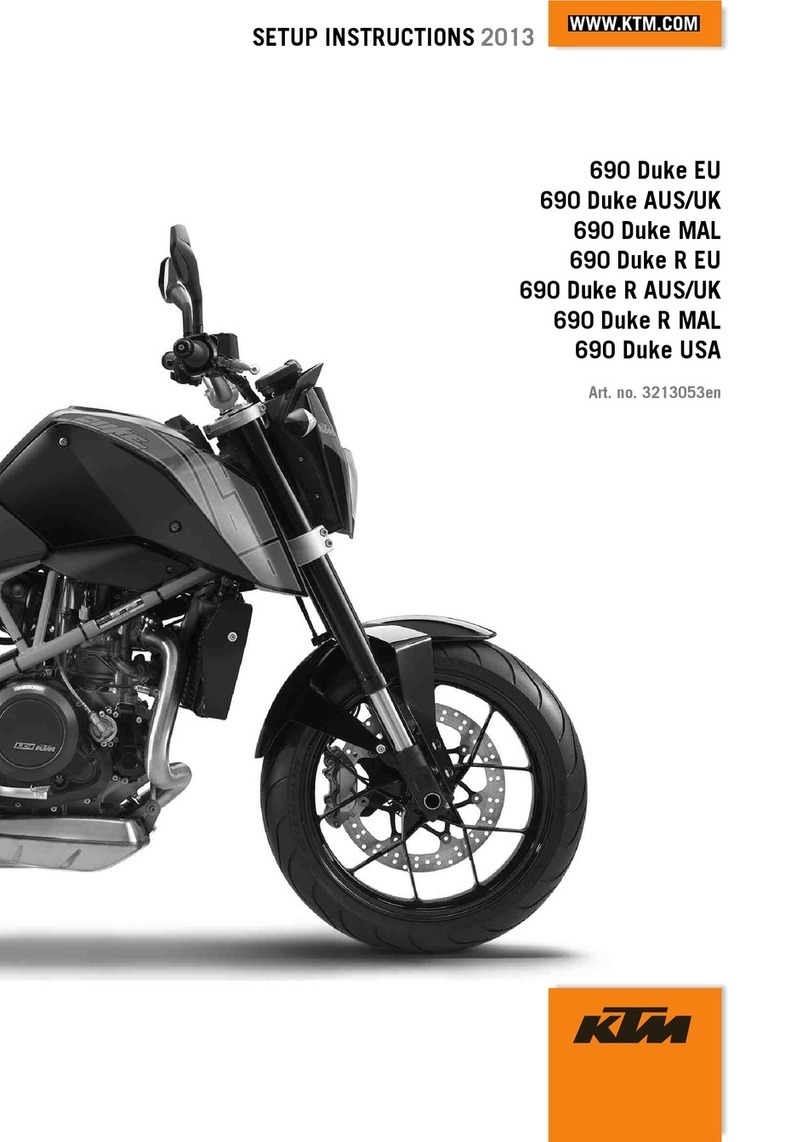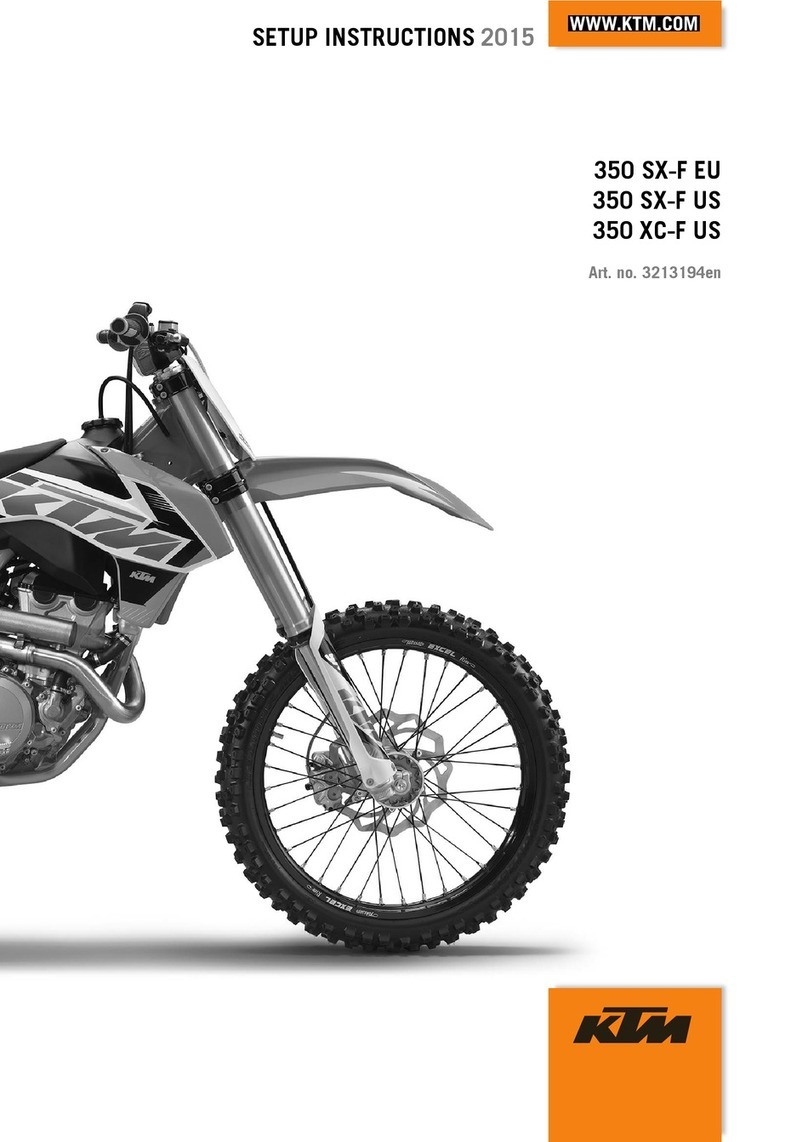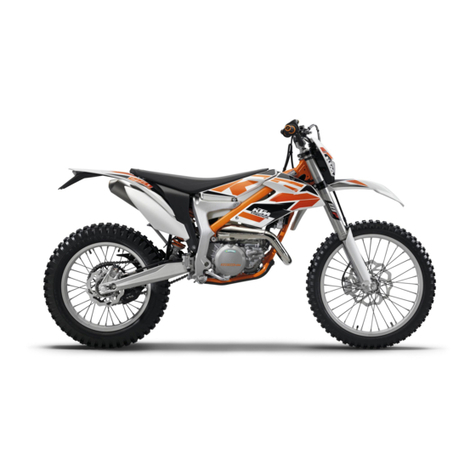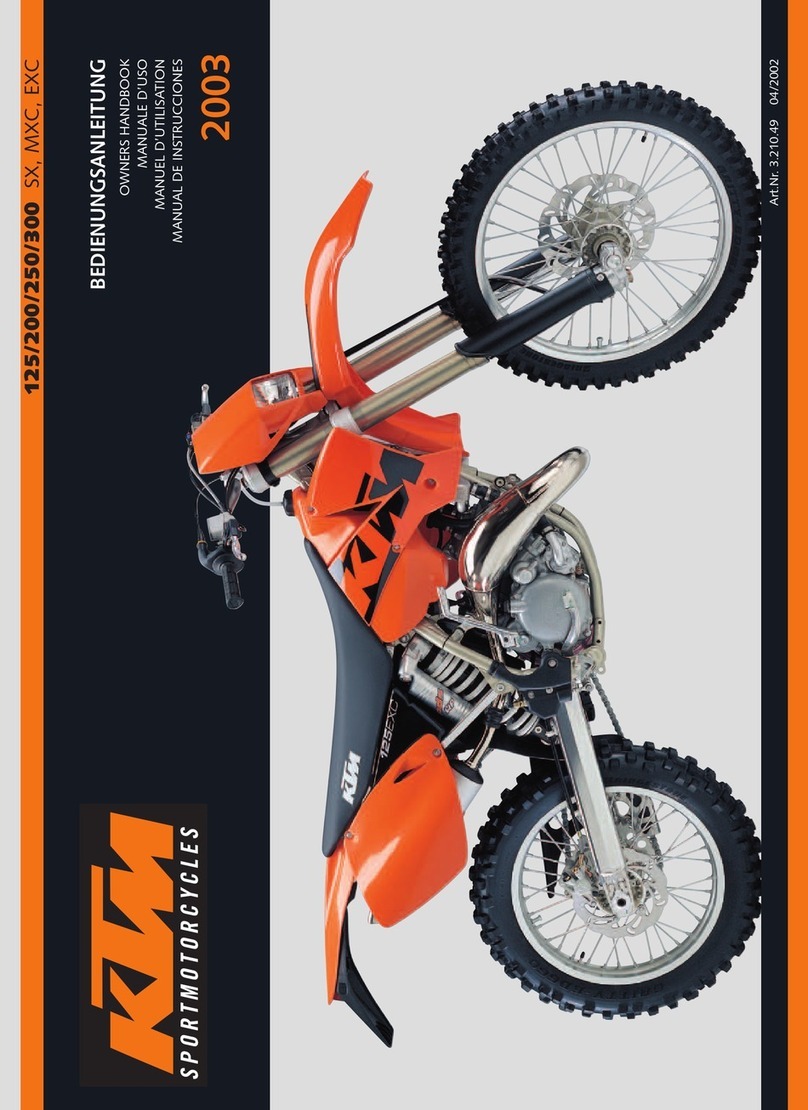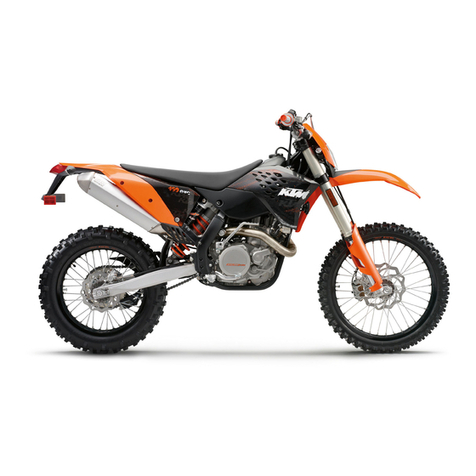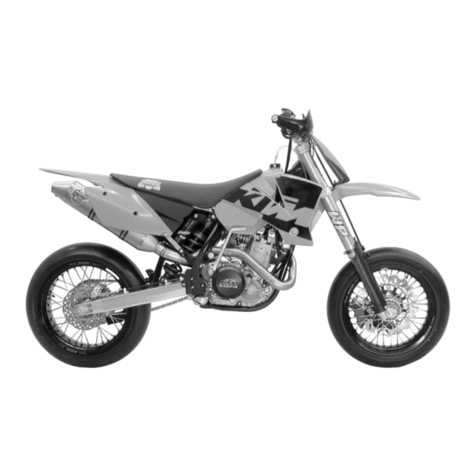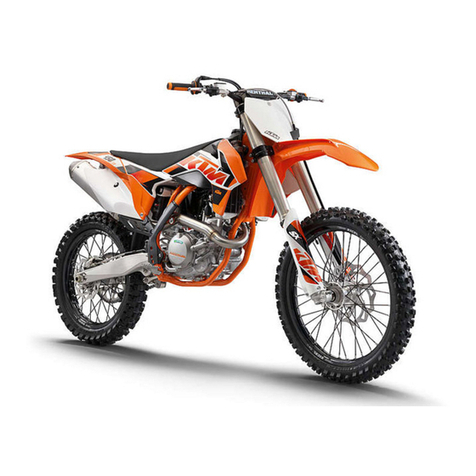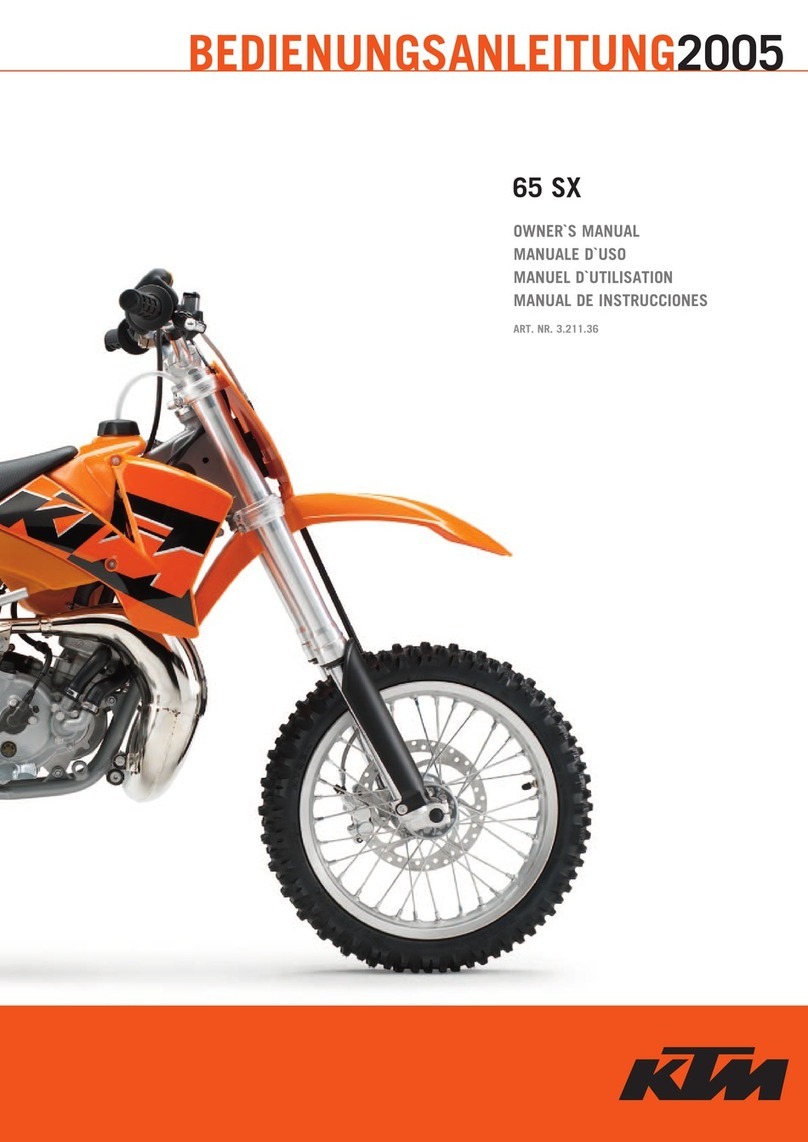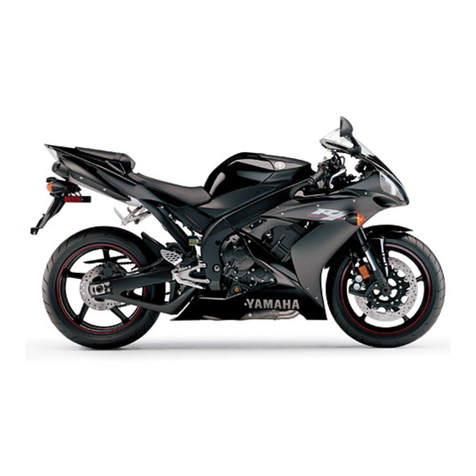ENGLISH
4
Kickstart instructions
Start as described above, then push the kickstarter hard all the way.
WARNING
WHEN STARTING THE ENGINE, PUT ON MOTORCYCLE BOOTS IN ORDER
TO AVOID INJURIES. YOU MAY SLIP OFF THE KICKSTARTER, OR THE ENGINE
MAY STRIKE BACK WHEN KICKING NOT VEHEMENTLY ENOUGH.
Starting off
Pull the clutch lever. Put the engine into first gear, slowly
release the clutch lever and open throttle at the same time.
WARNING
B
EFORE YOU START OFF
,
CHECK THAT THE CENTER STAND HAS BEEN
SWUNG RIGHT UP TO THE TOP
. I
F THE STAND DRAGS ON THE GROUND
,
THE MOTORCYCLE CAN GO OUT OF CONTROL
.
Shifting/Riding
You are now in first gear, refered to as the drive or uphill gear.
Depending on the conditions (traffic, road gradient, etc.), you
can shift to a higher gear. Close throttle, at the same time pull
clutch lever and shift to the next higher gear. Let clutch lever
go again and open throttle. If you turned on the choke, make
sure you turn it off again as soon as engine is warm.
When you reach full speed through turning the throttle grip all
the way, turn throttle back to 3/4; the speed hardly decreases
although the engine will use less gas. Never open the throttle
wider than the engine can handle. Excessive turning of the
throttle grip will increase full consumption.
By shifting down, use the brakes if necessary and close throttle
at the same time. Pull clutch lever and shift down to the next
gear. Let clutch lever go slowely and open throttle or shift
down again.
If the engine is killed f.ex. at a crossing, simply pull the clutch lever
and start. It is not necessary to switch the gear to NEUTRAL.
WARNING
–OBSERVE THE TRAFFIC REGULATIONS, DRIVE DEFENSIVELY AND TRYING
TO LOOK AHEAD AS FAR AS POSSIBLE SO THAT ANY HAZARDS CAN BE
RECOGNIZED AS EARLY AS POSSIBLE.
–A
DJUST YOUR DRIVING SPEED ACCORDING TO THE CONDITIONS AND
YOUR DRIVING SKILLS.
–DRIVE CAREFULLY ON UNKNOWN ROADS
–NEVER LEAVE A HELMET ATTACHED TO HELMET LOCK WHEN RIDING
YOUR MOTORCYCLE BECAUSE THE HELMET CAN GET CAUGHT IN THE
REAR WHEEL AND THROW THE VEHICLE OUT OF CONTROL.
–R
EPLACE THE HELMET VISOR RESPECTIVELY GOGGLE GLASSES IN PLENTY
OF TIME. WHEN LIGHT SHINES DIRECTLY ON SCRATCHED VISOR OR
GOGGLES, YOU WILL BE PRACTICALLY BLIND.
–A
FTER FALLING WITH THE MOTORCYCLE, CHECK ALL FUNCTIONS
THOROUGHLY BEFORE STARTING UP OPERATIONS AGAIN.
!
CAUTION
!
–H
IGH RPM RATES WHEN THE ENGINE IS COLD HAVE AN ADVERSE
EFFECT ON THE LIFE OF YOUR ENGINE. WE RECOMMEND YOU RUN
THE ENGINE IN A MODERATE RPM RANGE FOR A FEW MILES GIVING IT
A CHANCE TO WARM UP. AFTER THAT NO FURTHER PRECAUTIONS IN
THIS RESPECT NEED BE TAKEN.
–S
HIFT TO THE NEXT HIGHER GEAR BY 8500 RPM AT THE LATEST.
–
N
EVER HAVE THE THROTTLE WIDE OPEN WHEN CHANGING DOWN TO A
LOWER GEAR
. T
HE ENGINE WILL OVERSPEED
,
DAMAGING THE VALVES
.
I
N ADDITION
,
THE REAR WHEEL BLOCKS SO THAT THE MOTORCYCLE
CAN EASILY GET OUT OF CONTROL
.
–IF THE RED COOLING LIQUID TEMPERATURE LAMP LIGHTS UP WHILE
YOU ARE DRIVING, THIS INDICATES COOLING SYSTEM TROUBLE. IMME-
DIATELY STOP AND TURN OFF THE ENGINE. DRIVING WITH THE WAR-
NING LAMP ON WILL CAUSE ENGINE DAMAGE.
– PLACE A CLOTH ON THE RADIATOR CAP. OPEN THE CAP SLOWLY,
SO THE EXCESS PRESSURE IN THE COOLING SYSTEM CAN ESCAPE.
CAUTION SCALDING HAZARD! - AND CHECK THE COOLING
LIQUID LEVEL.
–
DO NOT DRIVE ON, UNTIL THERE IS SUFFICIENT LIQUID IN THE COO-
LING SYSTEM. HOWEVER, CALL ON ONE OF KTM’S DEALERS AS
SOON AS POSSIBLE IN ORDER TO HAVE THE DEFECT REMEDIED.
–IF ANY ABNORMAL VIBRATIONS OCCUR WHILE DRIVING, CHECK THAT
THE ENGINE FASTENING SCREWS ARE TIGHT.
–I
N THE EVENT THAT, WHILE RIDING YOUR MOTORCYCLE, YOU NOTICE
ANY UNUSUAL OPERATION-RELATED NOISE, STOP IMMEDIATELY, TURN
THE ENGINE OFF, AND CONTACT AN AUTHORIZED KTM DEALER.
Braking
Close throttle and apply the hand and foot brakes at the same
time. When driving on sandy, wet or slippery ground use
mainly the rear wheel brake. Always brake with feeling,
blocking wheels can cause you to skid or fall. Also change
down to lower gears depending on your speed.
When driving downhill, use the braking effect of the engine.
Change down one or two gears but do not overspeed the
engine. In this way, you will not need to brake so much and
the brakes will not overheat.
WARNING
WHEN YOU BRAKE, THE BRAKE DISCS, BRAKE PADS, BRAKE CALIPER AND
BRAKE FLUID HEAT UP. THE HOTTER THESE PARTS GET, THE WEAKER THE
BRAKING EFFECT. IN EXTREME CASES, THE ENTIRE BRAKING SYSTEM CAN
FAIL.
Stopping and parking
Apply the brakes fully and put the engine into neutral. To stop
the engine, switch off the ignition. Close fuel tap. Park on solid
ground and lock the vehicle.
WARNING
–NEVER LEAVE YOUR MOTORCYCLE WITHOUT SUPERVISION AS LONG AS
THE ENGINE IS RUNNING.
–MOTORCYCLE ENGINES PRODUCE A GREAT AMOUNT OF HEAT WHILE
RUNNING. THE ENGINE RADIATORS, EXHAUST, EXHAUST SYSTEM, BRAKE
DISCS, AND SHOCK ABSORBERS CAN BECOME VERY HOT. DO NOT
TOUCH ANY OF THESE PARTS AFTER OPERATING THE MOTORCYCLE,
AND TAKE CARE TO PARK IT WHERE PEDESTRIANS ARE NOT LIKELY TO
TOUCH IT AND GET BURNED.
–N
EVER PARK YOUR MOTORCYCLE IN PLACES WHERE THERE EXIST FIRE
HAZARDS DUE TO DRY GRASS OR OTHER EASILY FLAMMABLE MATERI-
ALS.!
CAUTION
!
–P
ARK YOUR MOTORCYCLE, SO THAT IT RESTS STABLY ON THE SIDE-
STAND (HARD GROUND, LEVEL SURFACE) AND CAN’T TIP OVER.
–T
HE FUEL TAPS MUST ALWAYS BE CLOSED WHEN PARKING THE
MOTORCYCLE. OTHERWISE THE CARBURETOR CAN OVERFLOW AND
FUEL COULD FLOW INTO THE ENGINE.
–A
LWAYS TAKE OUT THE IGNITION KEY WHEN PARKING YOUR
MOTORCYCLE SO THAT IT CANNOT BE USED BY UNAUTHORIZED
PERSONS.
